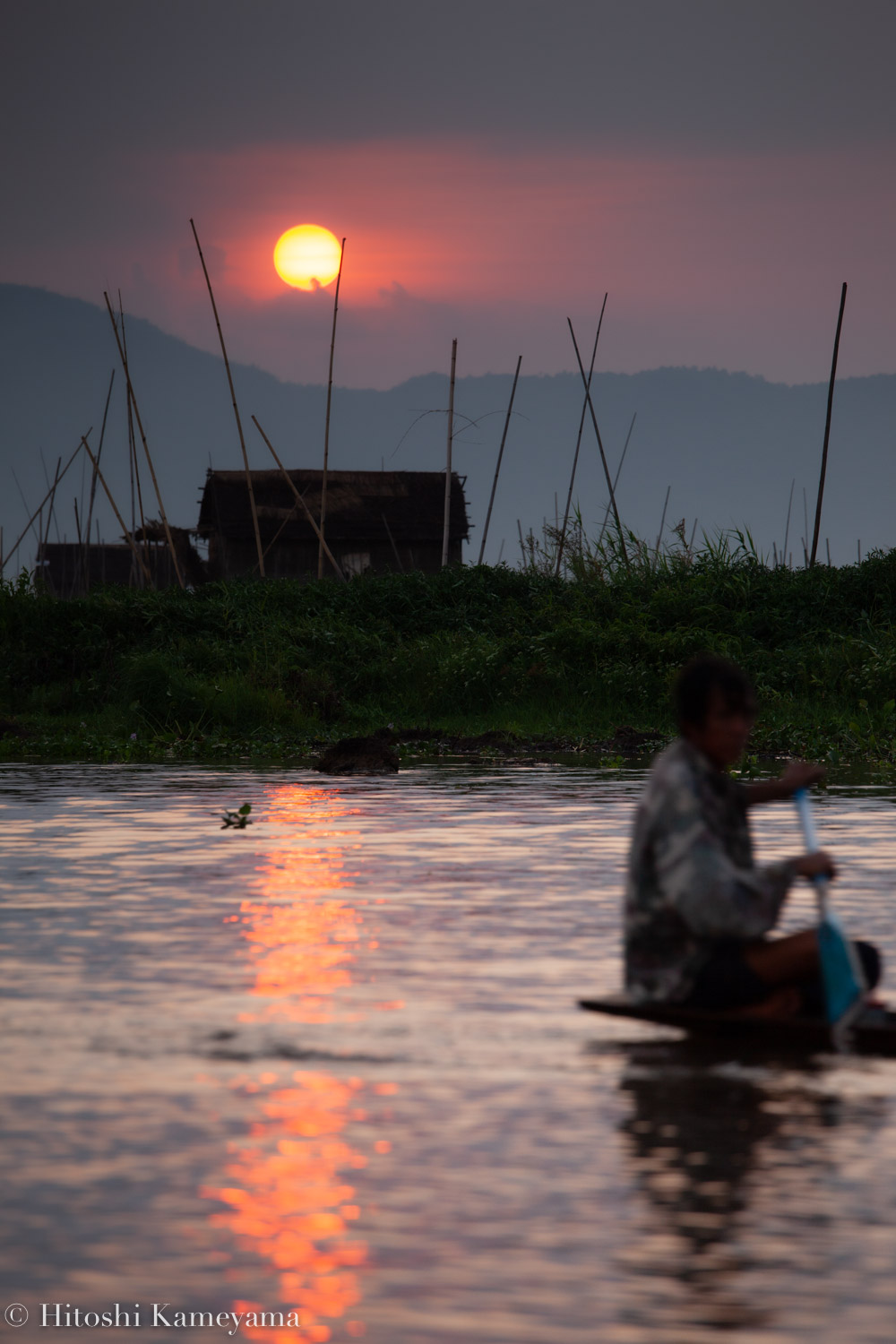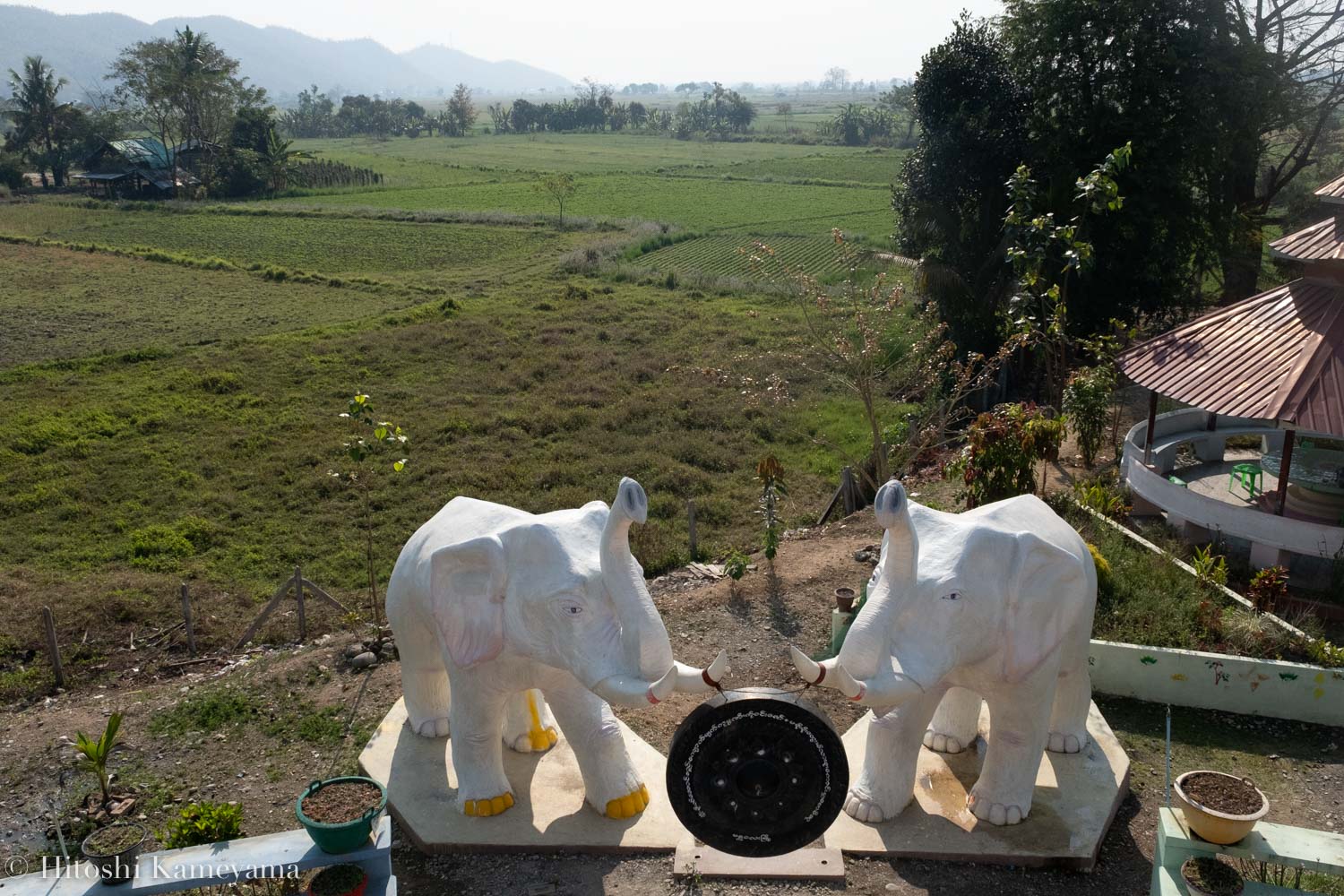She is Myanmarese singer-songwriter Ah Moon. I first learned about her from a Japanese TV show. The broadcast discussed Myanmar’s young artists, and the identity-crisis of their country. The rapid changes and increasing influence from outside meant many of the things they cherished were going to be lost. This was particularly important amongst the younger generation. One of these people was Ah Moon. While listening to her song “Myanmar”, I was deeply affected by its message, which went on to have a big influence on the concept of this book. After I mentioned I wanted to include her lyrics in this book, I visited her home in Yangon and heard her story. She became one of my valued friends in Myanmar. (Quoted from “Myanmar 2005 – 2017” afterword)
Blog Archives
School route
On this particular day, I wanted to take a photo of a certain scene, but it happened to be raining since the morning; so I just stayed and relaxed at the hotel waiting for the rain to stop. However, it continued raining into the afternoon, and as I looked out on to the surrounding mountains, I was unable to see any breaks in the clouds. According to the hotel staff I had become friendly with and the guides and boatmen I had talked to, the best time to visit the location to capture that scene seemed to be just after 3 p.m. It took about 30 minutes to get there from the hotel by boat, so I wanted to set out for the location at least by 2:30 that afternoon.
The rain started to ease up a little just after 2 p.m., and as the wind was slowly blowing the clouds from south to north that day, I could see the southern sky begin to brighten. Even though it was still raining lightly, I headed out from the hotel at the last minute, at 2:30 p.m.
My destination was a 500 meters long wooden bridge in the village of Maing Touk on the shores of the Inle Lake. I heard that this is the only bridge of its kind stretching over this expansive lake. The guide told me that although the lake’s water level varies by several meters between the wet and dry seasons, the level change was even larger in this area compared to others for geographical or similar reasons. Since the local people use boats to get around the lake area, a former village chief was especially adamant that this bridge be built.
Even though this bridge cannot be found in any guidebook, it has become somewhat of a well-known tourist attraction within Myanmar.
The boat stopped on the lake near the bridge just after 3 p.m., and as I waited there, a group of children who had just finished school came walking to the lake. There was a fairly wide jetty at the end of the bridge, where the children would get on the boats to return together to their villages.
First came the students of the lower grades of elementary school, followed by those of the higher grades and finally the junior high school students. Even though the jetty had no fences or handrails, the children ran around innocently without a care in the world. While watching, I couldn’t help but feel anxious that some of them might accidentally fall in the lake each year.
It is said that such bridges will become a thing of the past, as development around the Inle Lake area surges ahead. For this reason, I could not miss the chance to preserve on film the scene of these children walking happily by the lake.
House of Memories
I left Junction Square, the latest place to be for Yangon’s youth, and set out walking toward the House of Memories. Several years ago, it would have been unthinkable to use smart phones and GPS to navigate our way to a destination, as we do now. Although these tools are convenient, they may have eliminated the enjoyable experience for lost tourists like myself of clumsily asking the way in a language difficult for the locals to understand.
A Japanese acquaintance who runs a travel agency and I decided to meet up; it was his recommendation to visit the House of Memories. I knew about this place from Japanese TV and other sources, and so I had always wanted to visit there.
This Western-style building made of teak used to be the headquarters of General Aung San’s Burma Independence Army. Now it has been transformed into a famous restaurant popular for the traditional Burmese cuisine they serve; it has even been featured on Japanese TV programs and in other media.
After about 20 minutes of walking, the navigator suggested I turn left. For such a well-known restaurant I couldn’t find any kind of signboard. Nevertheless, I kept following the navigator, entered a side street and went a little further down to find an elegant building nestled in the back area.
I had an hour until I was meant to meet my friend. When I explained my situation to the waiter, he understood and led me up to the second floor.
This was once the office that General Aung San actually used during World War II, which is now open to the public. Upon entering, I saw an old typewriter on top of a large desk, and behind the desk was a chair with presence. When I sat in it, my eyes were drawn to a portrait of the famous general, gazing at me with a soft and welcoming expression.
Hanging on the walls were various pictures and documents that gave a glimpse of the life of General Aung San, who was assassinated midway through Burma’s fight for independence.
Among the photos were family portraits taken during the childhood of the General’s daughter Aung San Suu Kyi, who led Myanmar on its path to becoming the democratic nation it now is. They looked like any ordinary photos of a happy family. It was probably impossible to imagine at the time these photos were taken that this father and his daughter would go on to lead such tumultuous lives guiding their nation.
Myanmar is now opening up to the world, as it embarks on a path to development.
I will pay continuous attention to how Myanmar progresses on this path while addressing the various issues it faces both within the country and abroad.
Exchanges through photos
One day in August 2016, I was having a meal with some friends from Yangon, when the talk turned to my hobbies of photography and creating artworks; this subsequently led to a request for me to give a talk to Myanmar high school students who had started learning photography.
Mr. Zaw Min, who worked and lived in Japan for 10 and several years, is fluent in Japanese and runs a travel agency in Myanmar; he is also engaged in a variety of activities as a photographer. Mr. Min is someone who actively works to connect Myanmar and Japan. He started commenting during the meal that, ever since he saw the Shashin Koshien, which is a nationwide high school student photo competition held annually in Higashikawa, Hokkaido, he’s been longing to hold a similar event in Myanmar. However, there are no photography clubs in Myanmar’s high schools; to be precise, there are practically no club activities at all. So, the first step was starting up some clubs.
Mr. Min had the idea of getting high school students in Myanmar to take part in the International High School Student’s Photo Festival Exchange this summer as a new opportunity, and was working hard to make it a reality; in fact, Myanmar’s participation was officially confirmed just the other day.
Every Wednesday and Saturday, Mr. Min teaches photography as a volunteer at an art school in Yangon. As there is no class majoring in photography there, he’s gathered together some painting major students who are interested in taking photos. The school has no photographic equipment though, and it’s easy to imagine how difficult it would be for the students to procure such equipment themselves. So Mr. Min called on his photographer friends and collected some of their old cameras for the students to use. After hearing about his noble aspirations, I also gathered some of my own cameras lying unused at my home, and together with the help of my friends in Japan, I was able to donate five digital single lens reflex cameras when I gave a talk to the students.
In my talk, which was interpreted by Mr. Min, I spoke for roughly two hours about what brought me to Myanmar, the defining picture that led me to start creating artworks, and the pictures taken at a specific timing and composition. I also discussed the wonder of coincidences in taking photos, and the local people I’d met and connections formed through my photography.
My talk was attended by Myanmar high school students and their teachers, as well as students and teachers of an art college in the suburbs of Yangon, and some of Myanmar’s photographers interested in me.
During my time in Myanmar taking photos and creating artworks, I’ve learnt and gained many things from the country. In return, for several years I’ve been serving as a board member of a local NPO operating in Myanmar.
The NPO supports the independence of people living in remote farming villages, where there is no access to medical care or education.
To be honest, I feel an ambivalence when I consider the gap in reality between supporting farming villages with barely any lifelines such as hospitals and schools, and providing assistance to a high school photography club. Nevertheless, as I’ve formed a connection with Myanmar and its people through taking photos, I also feel joy and a sense of purpose in whatever contribution I can make through photographic activities.
I hope to continue helping the people of Myanmar enjoy photography in their daily life.
I’ve been asked to speak next at an art college in suburban Yangon, and I’m thinking of also talking about the photo book I’m currently creating.
This photo was taken after my talk. In the background is a famous Chinese-style building in Yangon, which is used as a location for TV dramas and movies.
monochrome XIV “shadow”
I have been participating since the 3rd exhibition. Every half year the pace of making the work according to the task is exactly right for me
7/Feb/2017 to 4/Mar/2017(Closed on Sunday Monday)
12:00 – 18:00
Gallery E&M nishiazabu, Tokyo Japan














